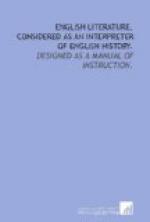Samuel Purchas, 1577-1628: like Hakluyt, he was exceedingly industrious in collecting material, and wrote “Hakluyt’s Posthumus, or Purchas, his Pilgrimes,” a history of the world “in Sea Voyages and Land Travels.”
Sir Walter Raleigh, 1552-1618: a man famous for his personal strength and comeliness, vigor of mind, valor, adventures, and sufferings. A prominent actor in the stirring scenes of Elizabeth’s reign, he was high in the favor of the queen. Accused of high treason on the accession of James I., and imprisoned under sentence of death, an unsuccessful expedition to South America in search of El Dorado, which caused complaints from the Spanish king, led to his execution under the pending sentence. He wrote, chiefly in prison, a History of the World, in which he was aided by his literary friends, and which is highly commended. It extends to the end of the second Macedonian war. Raleigh was also a poet, and wrote several special treatises.
William Camden, 1551-1623: author of Britannia, or a chorographic description of the most flourishing kingdoms of England, Scotland, Ireland, and the adjacent islands, from the earliest antiquity. This work, written in Latin, has been translated into English. He also wrote a sketch of the reign of Elizabeth.
George Buchanan, 1506-1581: celebrated as a Latin writer, an historian, a poet, and an ecclesiastical polemic. He wrote a History of Scotland, a Latin version of the Psalms, and a satire called Chamaeleon. He was a man of profound learning and indomitable courage; and when told, just before his death, that the king was incensed at his treatise De Jure Regni, he answered that he was not concerned at that, for he was “going to a place where there were few kings.”
Thomas Sackville, Earl Dorset, Lord Buckhurst, 1536-1608: author, or rather originator of “The Mirror for Magistrates,” showing by illustrious, unfortunate examples, the vanity and transitory character of human success. Of Sackville and his portion of the Mirror for Magistrates, Craik says they “must be considered as forming the connecting link between the Canterbury Tales and the Fairy Queen.”
Samuel Daniel, 1562-1619: an historian and a poet. His chief work is “The Historie of the Civile Warres between the Houses of York and Lancaster,” “a production,” says Drake, “which reflects great credit on the age in which it was written.” This work is in poetical form; and, besides it, he wrote many poems and plays, and numerous sonnets.
Michael Drayton, 1563-1631: a versatile writer, most favorably known through his Polyolbion, a poem in thirty books, containing a detailed description of the topography of England, in Alexandrine verses. His Barons’ Wars describe the civil commotions during the reign of Edward II.
Sir John Davies, 1570-1626: author of Nosce Teipsum and The Orchestra. The former is commended by Hallam; and another critic calls it “the best poem, except Spenser’s Faery Queen, in Queen Elizabeth’s, or even, in James VI.’s time.”




